|
|
 |


|
 |
Introduction
|
 |
"Big Load Afloat" issued 1965 by The American Waterways Operators, Inc. tells that the method of operating non-powered barges under pushing from astern by a powered boat was born as a reformation of "alongside-towing" in the river Mississippi or one of its tributaries seemingly something more than hundred years go, but the question "Who is the inventor ?" cannot find answer even now. But, the man who tried this method first in the world should be profoundly admired, because, in the past hundred years, it has grown up to a standard system of mass-transport in inland traffic not only in the United States but also in other continental countries.
In Japan consisting of four mountainous islands without navigable inland waterway, the introduction of push-barge method took place for the first time in 1963 for the transport of sand for building an artificial island in Kobe Harbour, and its high economical efficiency was so rapidly and widely acknowledged that the push-barge train has soon become the standard method of reclamation. Then, it was not so long before the shipping companies began to introduce this system for transporting limestone, coal, aggregates, etc., but such a rapid expansion was within an absolute limitation, because rope-connected trains had to be use in wavy sea from the first day of introduction and, in spite of great efforts and costs paid for improving navigability, the fields of their activity were limited within the western inland sea and larger bays.
Under these circumstances, we decided to work out a solution to the problem of navigability through developing mechanical coupler systems of articulate connection type, and, considering the characters of existing demands peculiar to Japan, we were obliged to follow two different ways --- one with the highest seaworthiness to cover ocean-going or unrestricted services and another with some limited navigability covering the sea states permitting reclamation work but capable of slipping, when so needed, to permit dumping of load of dump-barges without disconnection --- and decided to develop the latter type, slippable coupler, earlier because a greater number of demands could be expected. Before this stage, we had already had some experiences in treating rope-connection and articulate coupler of peculiar design, and, based on these experiences, it was intended to develop couplers having the following basic characteristics:
| |
-- The coupler should assure an excellent seaworthiness sufficient for the service area intended.
-- The coupler should connect the pusher to the barge at any point within the whole range of change of draught relationship without adjustment of draught, or at least with the least adjustment of draught.
-- The coupler should absorb all adverse influences of dimensional errors and misalignment inevitable in normal shipbuilding practice and elastic deformations of hulls, to keep a reliable and firm connection free of looseness.
-- Connection should take place without difficulty even when a slight relative heel is present between the pusher and barge.
--The coupler should be remote-controllable by the captain's finger-tip from the bridge of the pusher so that manual effort may not be needed for connection and disconnection.
-- Connection and disconnection should be accomplished in a short time,. In the event of dangerous accident such as collision of the barge with another ship, the pusher can be disconnected in a very short time.
-- During connected navigation, the crew on board should be free from shocks, vibrations and noises.
|
Nearly at the same time as our development of ARTICOUPLE, Mr. E. H. Fletcher, U.S.A., developed ARTUBAR which had two co-axial cylindrical pins with hemispherical heads to be inserted into bearings, with resilient bushing, on inside walls of barge's stern wings. The barge had upper and lower bearings corresponding to fully loaded and ballasted draught, respectively, and no intermediate connection point was considered. In other words, ARTUBAR had no "adapter", or "interface", compromising the different roles and characteristics of the two parts on two different vessels to be connected with each other, and, in design philosophy, had nothing in common with what we aimed at --- to endow several types of couplers with different characteristics to play different roles through introduction of different interfaces. To be concrete, two types of engagement were considered --- stepless friction-engagement and multi-step tooth-engagement and, afterwards, combination of these two types was added.
|
Articouple F (1972, ref. page "Articouple F")
|
 |
It was intended to develop a system which can keep navigability up to a wave height of 3 - 3.5 metres -- about twice the height permitting reclamation work -- and, in addition, permits slipping, when loosened, without perfect separation from the barge. It was believed that the only applicable functional momentum would be "friction" for which we already had experience of application. After several tentative designs, the following design principle was adopted :
| |
-- A vertical long "pressing shoe" with cross-section in equilateral trapezoid, with thick rubber lining on outer faces, is pivotally mounted at the end of each connecting pin. This trapezoidal cross-section has become the basic shaping of interfaces of various coupler types which followed.
-- A vertical "connecting slot" is formed in the inner wall of the barge's stern wing on each side. The slot has cross-section similar to that of pressing shoe and, when the shoe is inserted into the slot, the forward and rearward oblique walls will mate with their corresponding faces of the shoe, while a clearance will remain between the bottom of lot and the outer face of shoe.
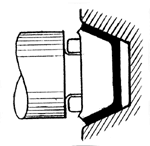 |
| Pressing Shoe & Connecting Slot |
 |
 |
| Akashi-maru & Dump-Barge (1972) |
 |
-- The shoe inserted into the slot is kept not to be pushed back by outer force and also kept under outward force by a hydraulic cylin-der so that its X- and Y-positions are determined by the shaping of slot and Z-position is determined by strong friction force caused by the high pressure on contact surfaces intensified by the wedge effect of two oblique surfaces. Thus, the coupler of this type is based on a peculiar principle to deep connection with static friction caused by constantly maintained outward force from hydraulic cylinder.
-- The pivotal mounting of pressing shoe absorbs the influence of relative heel of the pusher. This pivotal mounting was changed to spherical mounting afterwards.
-- When dumping load of dump-barge, the shoe is slightly retracted so that the friction force on oblique surfaces may disappear. Then, the shoe can slide along the slot when the load is dumped down and the barge floats up. Re-connection is possible by simple extension of connecting pins.
|
For realizing this design principle, it is necessary to confirm the degree of reliability of the "Friction force" as the primary factor of connection. Rubber was chosen as the high-friction material and about half a year was spent for study of physical and chemical properties of rubber including friction property, and the design and manufacturing process of rubber lining to be used as friction material. The first pusher "Akashi-maru" equipped with the first friction-coupler was delivered in summer 1972 and the performance was just as anticipated. Next year, 1973, seven pushers with friction couplers were built, and now, the number of boats with F-couplers exceeds 100.
|
Articouple H (1975)
|
 |
Along with the rise of reputation of Articouple-F, a demand has risen for a system with improved sea-worthiness covering ocean service and, in reply to such a demand, a new system was intended. The new system was not required to cope with change of draught relationship during navigation, while it had to assure the unrestricted service, and it was decided to develop a system, named Articouple H, of multi-step tooth-engagement type based on the following design principle :
| |
-- The connecting positions of the multi-step tooth-engagement are arranged vertically in a vertical slot, called "Socket", of cross-section in equilateral trapezoid, similar to the design principle of Articouple F.
-- The "Interface", called "Helmet", mounted on the connecting pin need not be long as no friction area is needed. As the X-, Y- and Z-positions of the helmet, inserted into the socket, must be determined at a single stroke, without looseness, only through supporting the helmet at the inserted position, the helmet must contact the socket at two oblique faces only. The teeth supporting the helmet can be fitted on the con-tacting faces only and, accordingly, the adoptable arrangement is that the helmet has teeth on both oblique faces, fore and aft, and the socket has multi-step teeth stepwise arranged on both oblique walls, fore and aft.
Then, when the helmet is inserted into the socket and prevented from being pushed back by outer force, the teeth of helmet engage with teeth on socket walls and the position of helmet is determined in X-, Y- and Z-directions
-- The helmet is mounted on the spherical head of connecting pin. At the top of helmet, a pin is inserted into a vertical round hole in line with the vertical axis of spherical head, and its lower end is inserted into a long hole in the surface of spherical head so that the helmet may be allowed for turning by plus/minus 3-3.5 degrees about X- and Z-axes to absorb adverse influence of probable misalignment and, at the same time prevent turn of helmet about Y-axis relative to the pin. The spherical head of the pin is gently supported by the spherical inner surface of helmet having an ample load carrying capacity.
-- The connecting pin, together with helmet, turns relative to the pusher's hull to permit free pitching of pusher relative to the barge.
-- The helmet can turn by plus/minus 3-3.5 degrees about X-axis and, even if the pusher has a heel within this angle relative to the barge, connection can take place without correcting the heel.
-- The helmet is fully retractable into the main bearing fixed to the shell of forecastle of the pusher. When retracted, nothing projects outside the shell.
| Helmet of Articouple H |
Helmet inserted into Socket |
Socket of Articouple H |
 |
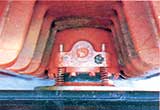 |
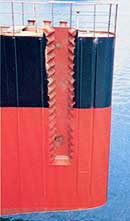 |
--The sockets of the barge are formed of channel pieces of steel casting, in equilateral trapezoid, having stepwise arranged equidistant ladder-like teeth, machined accurate, on two oblique walls and are welded to the inner walls
of the barge's stern wings. The length is to cover connectable draught range required.
|
Two pushers, Hachiko-maru and No.2 Hachiko-maru of 4,600 HP with Articouple-H, and two hold-barges of 8,950 DWT with cargo-handling gear were built to NK classification for unrestricted service, and, afterwards, a deck-loading barge of 6,500 DWT classed with ABS was added. The fleet was employed for transport of logs from Littoral Province of Siberia to Japan in summer season and for other cargoes from/to other places in winter. In the first winter 1972-73, they were operated in the routes Japan to China and from the next winter in the routes to South-East Asia down to Indonesia, and, afterwards, to Rabaul, New Britain Island, east of Papua New Guinea.
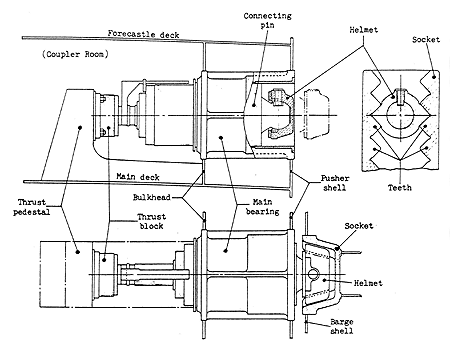 |
Next to Japanese fleet, Russian Far Eastern Shipping Corporation built in 1977 four pushers of 6,000 HP with Articouple-H and eight deck-loading barges of 9,000 DWT for the transport of logs from Littoral Province of Siberia to Japan over the Sea of Japan all the year round. These vessels were classed with RS for unrestricted service and ice-strengthened, and they exhibited satisfactory performance in 6 - 8 metres high, short and steep waves in the Sea of Japan in winter season.
Experiences with Articouple-H couplers of these Japanese and Russian fleets were enough for us to confirm the conviction on the competence and reliability of our coupler technology in general as well as in details of design. Although Articouple-H type was replaced with K type afterwards as stated below, many important items of its design philosophy and details are inherited by various successors.
In the stage of development of Articouple-H, there were two observations --- whether the teeth should be provided on both oblique walls of socket or they should be on one (rearward) oblique wall only and the other wall should be a vertical flat wall. But, on the other hand, we were convinced that finer steps, or smaller intervals between teeth would result in easier connection work and the teeth provided on one side only needing wider intervals to maintain necessary strength of teeth would be more inconvenient in handling. In this connection, it was also studied to provide teeth in plurality on both sides of helmet, for example 3 by 3 forward and rearward sides, to make the intervals between connecting positions smaller. But this proposal was not adopted because uneven time-wear of teeth of sockets was considered inevitable after use for a long time --- 15 to 20 years --- and, as the results, uneven distribution of load due to uneven contact --- total load on two teeth or even on one tooth only --- was anticipated. So, the type "one tooth on each side" combined with socket with double-row teeth was adopted.
But our above-mentioned fixed idea was turned over by the experience of the captain of the first Articouple-H pusher "Hachiko-maru". He was an excellent captain having served as captain of the first Articouple-F pusher "Akashi-maru" and had the largest experience in dealing with Articouple-pushers.
As a recommendation based on his own experience of actual use, he said wider intervals between teeth would make connection easier.
In addition, different from Articouple-F, Articouple-H had a drawback that longitudinal (fore-and-aft) pre-positioning of pusher was needed before connection and, for this purpose, the pusher had a "Positioner" independent of the main coupler.
So, the conclusion was self-evident. Manufacture of Articouple-H couplers was interrupted up to the 6th set --- 2 Japanese and 4 Russian. The rhombus-like double-toothed helmet was changed to pentagonal single-toothed one, the double-row teeth sockets changed to single-row teeth and the positioner removed, and all other design philosophy and experiences were transferred to the next improved type Articouple K. Even the manufacturing cost was doubtlessly reduced.
 |
| Hachiko-maru & Cargo Barge (1975) |
 |
No. 2 Hachiko-maru on return after 3,000 miles' voyage from Indonesia
(Photo 14 Oct. 1979) |
|
Articouple K (1980, ref. page "Articouple K")
|
 |
Articouple K was born as an improvement of Articouple H. The cross-section of the helmet and socket were changed into asymmetric trapezoid with the rearward side with teeth parallel to Y-axis for easier manufacture. The oblique forward side is utilized for longitudinal (fore-and-aft) positioning which will take place in the course of connection. This manner of shaping has an effect to improve stable motion of helmet during connection and disconnection and connection under some influence of waves has become possible to a certain degree. All other merits of Articouple H were inherited by Articouple K.
The first two units of Articouple K were exported to Scandinavia. Then, several demands from domestic owners followed and, in parallel, demands from Scandinavia were repeated up to 14 units in total. 10 of them are of a same type of deck-mountable design and arranged to be swappable with one another so that cooperation over borders may be possible. Some of these boats were converted from existing tugs through addition of deck-mountable couplers.
In addition to the superexcellent reliability, one of the merits of Articouple K is, practically speaking, the absence of wearing parts needing periodical renewal.
Articouple and Triofix couplers are designed for hydraulic drive by means of hydraulic cylinders. But there are two exceptions designed for rotary hydraulic motor powered threaded shaft drive, named KM. These two units, with ABS classification approval, were exported to Argentine in 1981 to form 180 m long trains with articulation at mid-length, each consisting of two 90 metres long oil barges, powered and dumb.
 |
| Valkyrien & Coal Barge in North Sea |
| Deck-mountable KD coupler & socket of barge |
Fully retractable helmet of
forecastle-side mountable KC-coupler |
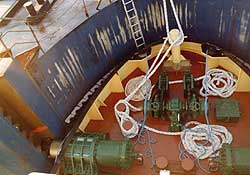 |
 |
|
Articouple FR (1984, ref. page "Articouple FR")
|
 |
In reply to various owners' demand for a system permitting dumping of load of a dump-barge without separation and, at the same time, assuring a good seaworthiness, a coupler of combined friction- and tooth-engagement principle was developed as Articouple FR.
The first FR-pusher was converted from a rope-connected pusher and was used to operate a tank barge for offshore dumping of industrial wastes in the area more than 50 nautical miles from shore. The second one was a sand barge which was converted afterwards to a dredge barge with a sand pump. The performance of Articouple FR in "Draught adjustment" was sufficient to cope with the rapid change of draught due to loading by the sand pump in waves 3 - 4 metres high. Then, a number of dredge barges with FR-couplers were built, and, in addition, Fr-couplers were employed even on a number of ordinary cargo barges because of its convenience in use --- cargo-handling utilizing "Draught adjustment" without separation of pusher.
In addition, the presence of friction component assists to easier connection under the influence of waves because friction-connection can serve as the provisional connection before proceeding to the final combined friction/tooth-engagement connection.
.
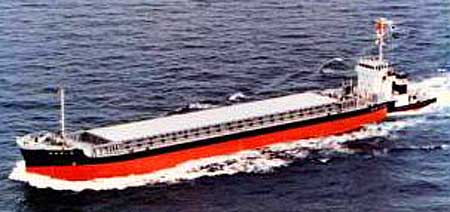 |
| Shintomei-maru & Limestone Barge (1986) |
 |
| No. 18 Daikyo-maru & Dredge Barge (1993) |
|
Triofix TRF (1989, ref. page "Triofix TRF")
|
 |
The development of various types of Articouple has improved convenience in use remarkably, but, nevertheless, the matter of the owners' greatest concern --- Speed ---remained unsolved. In articulate connection permitting free relative pitching, a wide clearance must be left in front of the pusher's bow to prevent hitting of pusher's stem against the barge's stern notch wall, and eddies occurring in the open bottom of this clearance cause large water resistance. This is the very reason of the inevitable low speed of push-barge trains and, for realizing a drastic improvement of propulsive performance through suppressing generation of eddies, the rigid connection needing no clearance for permitting relative pitching is the only measure.
In reply to an owner's request for a high-speed limestone barge of 10,000 DWT for long distance run, with draught-adjustable coupler, a new 3-pin supported rigid connection coupler Triofix TRF was developed.
Though the side coupler unit of Triofix TRF may seem to resemble Articouple FR in external appearance their constructional principles are different from each other because of the characters of load components are different.
The results of the first Triofix TRF were satisfactory --- comfortableness to crew on board because of absence of relative pitching and easy connection under influence of waves. After this first 10,000 tonner, a number of dredge barges connected with Triofix TRF were built.
In the case of ordinary cargo barges or tankers, the bow unit may be a simple wedge-shaped coupler. In dredge barges which followed in plurality, however, rapid adjustment of draught is required due to rapid loading with a sand pump in 3 - 4 metres high waves, and the bow unit should preferably be of combined friction/tooth engagement similar to the side unit. This type is called Triofix TRF-F.
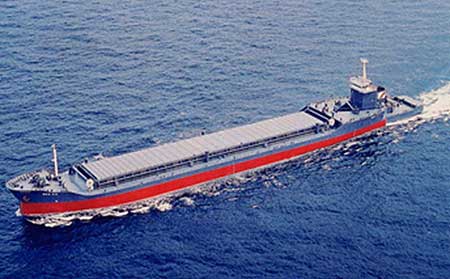 |
| Tosa & Limestone Barge (1989) |
|
Triofix TR (1990, ref. page "Triofix TR")
|
 |
A number of non-powered floating cranes are operated with Articouple-pushers in Japan because of their easy manoeuvring and positioning. In compliance with an owner's desire to fix the pusher at the end of the pontoon of floating crane so that the total effective length of the combination, moving as a single floating body, may be increased for the purpose of reducing trim when lifting load, a new 3-pin supported rigid connection coupler of an extremely simple construction was developed as Triofix TR. The results were satisfactory. Afterwards, several cargo barges were built to be operated by pushers with Triofix TR.
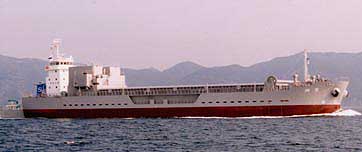 |
| Shintosa-maru & Limestone Barge (1996) |
|
Triofix TK (2000, ref. page "Triofix TK")
|
 |
Although the policy to apply Triofix TK, using Articouple K as side coupler units, to larger cargo and tanker barges had been settled long before, such a chance has not come. Triofix TK was applied to 30,000 tonners' fleet of Italian ILVA for the transport of steel coils from Taranto steel mill to Genova along Italian coast and the performance was just as anticipated. Triofix TK is most appropriate for larger cargo and tank barges to be operated in long distance services with high speed.
 |
| Ursa Major & Cargo Barge |
|
Finally
|
 |
Most of the fundamentals of technical philosophies forming the basis of Taisei Engineering's push-barge technology were established in the first 3 - 4 years in the course of development of Articouple F and H, namely :
| |
-- Articulate connection realized by two co-axial connecting pins extended transversely from the pusher and supported at ends by receiving means on the inner walls of barge's stern wings to permit free pitching of pusher relative to the barge.
-- "Adapter" or "interface" mounted at pin-end assuring reliable connection with said receiving means previously arranged vertically on said inner wall at heightwise intervals much smaller than the diameter of the pin. Connection can take place without adjustment of draught or with a least adjustment of draught previously.
-- Barge's each receiving means, P- and S-side, formed as a vertical slot long enough to cover the connectable draught range required.
-- Said "adapter" or "interface" and said slot shaped in trapezoid in horizontal cross-section so that X- and Y-positions of the former may be determined by a single stroke of insertion into the latter.
-- Said "adapter" or "interface" kept in contact with said slot at their two oblique surfaces only and a small clearance is left between the "top" or "outer end" of interface and "bottom" of slot for realizing the above-mentioned determination of position in X- and Y-directions.
-- Oblique contact surfaces are utilized as friction-surfaces or fitted with teeth for mechanical engagement for determining Z-position of "adapter" or "interface".
-- Said "adapter" or "interface" spherically mounted at pin-end to absorb influence of probable misalignment and relative list and, at the same time, to assure an ample load carrying capacity.
-- Connecting pin with "adapter" or "interface" at its end supported at extended position to prevent it from being pushed back by outer force.
|
The first pusher with Articouple F, "Akashi-maru" and dump-barge, and the first pusher with Articouple H, "Hachiko-maru" and cargo barge, were built to Taisei Engineering's own designs, because "How to use the new coupler system" from the shipdesigner's point of view constituted an important part of the development of the new system itself,
The technology of ocean-going articulate push-barge train was established already in 1975 with Articouple H. Then, the established basic technology was supplemented by additional concepts and techniques along with the development of various types which followed in order to satisfy the owners' demands and desires of various types and characters in the best ways.
In the course of these development, Triofix system was born by addition of a simple bow coupler unit. Triofix TRF is based on a particular structural pattern which was worked out to cope with the difference of characters of wave-excited loads between articulate and rigid connections clarified by the load analysis. Triofix TR is an exception from the design principle set force above, and its unique, simple design is practicable because its purpose is the 3-point supported rigid connection.
In the past 30 years' experience, the sizes of barges ever covered by these couplers extend from 150 DWT to 30,000 DWT, and the number of couplers ever delivered has exceeded 210. Now, different from monochromatic products of other manufacturers, Taisei Engineering has a really versatile technology holding 3 types of articulate couplers ARTICOUPLE and 3 types of rigid connection couplers TRIOFIX which are sufficient to cover all the probable types and sizes of the owners' needs for push-barge systems.
|
|